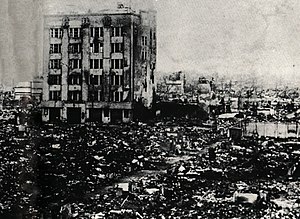The bombing of Kōfu (甲府空襲, Kōfu kūshū) was part of the air raids on Japan strategic bombing campaign waged by the United States against military and civilian targets and population centers of the Empire of Japan during the Japan home islands campaign in the closing stages of the Pacific War in 1945.[1]

Background
editKōfu is a medium-sized population center and the capital of rural Yamanashi Prefecture. Many residents had the illusion that its surrounding mountains would provide some protection, and that without any targets of significant military importance,[2] Kōfu would be overlooked by the Americans. Numerous residents of Tokyo had relocated to Kōfu for safety. These included the noted authors Osamu Dazai and Masuji Ibuse.[3] However, as Kōfu was located near Mount Fuji, which was a prominent landmark, once air raids on Japan became more frequent during the final stages of the Pacific War, Kōfu residents became accustomed to the sight of American aircraft passing over the city at high altitude en route to targets in Tokyo and in Nagano Prefecture, and Kōfu occasionally became a secondary target for aircraft which missed their primary targets.[4] Such bombings caused little damage, and civil defense efforts did not begin until around March 1945; however, the construction of air raid shelters was largely impossible due to the high groundwater level, and efforts were largely limited to training civilian tonarigumi associations on using bucket brigades for firefighting.
Air raid
editThe main air raid on Kōfu was a firebombing attack, which occurred during the night of 6 July 1945,[5] beginning with a USAAF B-29 Superfortress bomber dropping 13 incendiary bombs directly on the Kōfu city hospital. Carpet bombing of the city then commenced by 230 B-29 bombers of the USAAF 39th Bombardment Group and 330th Bombardment Group. Due to cloud cover over the city, most planes released their payload of M47 napalm bomb and E-46 incendiary cluster bombs (the same as were used in the Tokyo air raid) from an altitude of between 13,400 and 14,600 feet (4,084 and 4,450 meters) using radar.[6]
A year after the war, the United States Army Air Forces's Strategic Bombing Survey (Pacific War) reported approximately 79% of the city’s urban area had been totally destroyed, with 740 civilians killed, and 1248 seriously wounded; with 35 people missing and 18,094 residences destroyed.[7]
See also
editNotes
edit- ^ Hoyt, Edwin Palmer (2000). Inferno: The Fire Bombing of Japan, March 9 – August 15, 1945. Lanham, Maryland: Madison Books. ISBN 9781568331492. LCCN 00027131. OCLC 606478232. Archived from the original on 7 March 2021. Retrieved 15 June 2021 – via Internet Archive.
- ^ Mapping Urbicide
- ^ Lyons, The Saga of Dazai Osamu
- ^ D'Olier, Franklin; Alexander, Henry C.; Wilds, Walter; Wright, Theodore P. (1 July 1946). Summary Report (Pacific War). United States Strategic Bombing Survey (Report). Washington, D.C.: United States Government Printing Office. pp. 1–34. Archived from the original on 1 February 2004. Retrieved 15 June 2021 – via Anesi.com.
- ^ Carter. The Army Air Forces in World War II: Combat Chronology, 1941–1945
- ^ 67 Japanese Cities Firebombed in World War II
- ^ Wainstock. The Decision to Drop the Atomic Bomb. Page 9
References
edit- Werrell, Kenneth P (1996). Blankets of Fire. Washington and London: Smithsonian Institution Press. ISBN 1-56098-665-4.
- Bradley, F. J. (1999). No Strategic Targets Left. Contribution of Major Fire Raids Toward Ending WWII. Turner Publishing. ISBN 1-56311-483-6.
- Carter, Kit C (1975). The Army Air Forces in World War II: Combat Chronology, 1941–1945. DIANE Publishing. ISBN 1-4289-1543-5.
- Crane, Conrad C. (1994). The Cigar that brought the Fire Wind: Curtis LeMay and the Strategic Bombing of Japan. JGSDF-U.S. Army Military History Exchange. ASIN B0006PGEIQ.
- Frank, Richard B. (2001). Downfall: The End of the Imperial Japanese Empire. Penguin. ISBN 0-14-100146-1.
- Grayling, A. C. (2007). Among the Dead Cities: The History and Moral Legacy of the WWII Bombing of Civilians in Germany and Japan. New York: Walker Publishing Company Inc. ISBN 978-0-8027-1565-4.
- Hoyt, Edwin Palmer (2000). Inferno: The Fire Bombing of Japan, March 9 – August 15, 1945. Lanham, Maryland: Madison Books. ISBN 9781568331492. LCCN 00027131. OCLC 606478232. Archived from the original on 7 March 2021. Retrieved 15 June 2021 – via Internet Archive.
- Lyons, Phyliss (1985). The Saga of Dazai Osamu: A Critical Study With Translations. Stamford University Press. ISBN 0804711976.
- Nalty, Bernard C (1999). War in the Pacific: Pearl Harbor to Tokyo Bay. University of Oklahoma Press. ISBN 0806131993.
- Shannon, Donald H. (1976). United States air strategy and doctrine as employed in the strategic bombing of Japan. U.S. Air University, Air War College. ASIN B0006WCQ86.
- Wainstock, Dennis (1996). The Decision to Drop the Atomic Bomb. Greenwood Publishing Group. ISBN 0-275-95475-7.